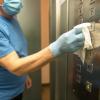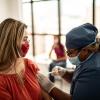
Elena Flowers (center) with students Katie Millar and Hamza Abid (photo and video by Elisabeth Fall)
Synthesizing the Personal with the Professional: A Genomics Journey, Part Four
Having my genome sequenced has taken me in some unexpected directions, and the journey continues to unfold. I’ve joked several times that this project has taken on a life of its own and in many ways, I’m just along for the ride. Without a doubt, it’s been a ride well worth taking, both personally and professionally.
Those two aspects of my life – the personal and professional – come together when I think about the role I want to play in society as we move forward in this era of genomics. The time and energy I’ve put into this experiment of having my genome sequenced have certainly helped me to have meaningful conversations with family, friends and colleagues about the many considerations these scientific advances have raised. I also hope that my story – told in this publication and beyond – is helping a wider circle of people contemplate their professional, ethical and personal roles as they pertain to genomics.
Some Professional Considerations
Professionally, I have a much-improved understanding of genomic testing. The “what” question is fairly straightforward – one that can be summed up as understanding the differences among whole genome, whole exome, gene panel and single gene tests and what each of these offers individuals, clinicians and researchers alike.
The “where” question is more complicated. Individuals can now undergo testing in many clinical settings. These include UCSF Medical Center, which now offers whole exome sequencing, as described in a previous post. Many gene panels and single gene tests are also available in clinical settings, commercial settings and through academic and research laboratories across the world – and there is the rapidly growing direct-to-consumer arena. Individuals will have to decide for themselves on an appropriate setting for testing, but I hope projects like mine and many others can inform their choices.
The “who” question – as in who should be tested – is related to the where and is also ethically and socially complex, because it taps into some of the biggest questions in health care today. Generally, there are no right answers to these questions. Many experts will argue, based on substantial evidence, that massive genomic screening of healthy individuals is not presently of any benefit in terms of health outcomes or costs. Yet individuals, particularly in the era of the “quantified self,” are often driven to this testing by an insatiable need to know.
This transitions us into the “why” question. Why undergo genetic testing at all? In some cases, the rationale to do so is strong. For example, if someone has a family history of disease and a proband with a known genetic risk factor and the condition has preventative measures available that can be applied to asymptomatic individuals, genetic testing can make a lot of sense. Consider someone with a family history of sudden cardiac death linked to one of several genes associated with long QT syndrome, who can potentially take advantage of a defibrillator implantation to prevent life-threatening arrhythmias. That person has very good reasons to be tested.
However, in most cases, the correct course is much less clear. Many diseases are far too complex in etiology for a single gene or panel of genes to definitively guide treatment. My own research is on type 2 diabetes. Numerous studies have identified genes that increase risk for type 2 diabetes, yet the addition of single genes or even panels of genes to risk prediction models hasn’t substantially improved our ability to find out which individuals will develop this disease. That’s why a major focus of research is how to better understand and characterize the combined effects of both genetics and environmental and behavioral factors in order to find out which individuals are most likely to develop type 2 diabetes.
Some Personal Considerations
On a personal level, while it’s been a challenge for me to share my nonscientific writing publicly and to be in front of a camera, I’ve truly appreciated hearing the impact this story has had on others. I’ve heard from colleagues who initially saw this as just an interesting experiment, who suddenly and unexpectedly found that they were personally affected with their own genetic testing choices, particularly questions around generational knowledge and children.
The personal considerations can be different depending on your age. Middle-aged and older patients who have been diagnosed with a disease that has known genetic risk factors could feel guilt and burden from knowing that, however unwittingly, they may have passed risk on to their children. For parents of young children, there are questions about whether and when testing is appropriate, what to do with the results and when to disclose results to children.
And for those who do not have children but think they may in the future, there are considerations around coupling that, for the most part, are entirely new in our society. For example, in 2014, a dating app partnered with a company that offers genetic testing so that users could have their genomic information incorporated into matchmaking algorithms. A quick web search suggests that this particular company is no longer in business, but this was three years ago, just as direct-to-consumer genetic testing was really starting to take off. It doesn’t seem impossible that these types of services will become more marketable in the era of the quantified self. Yet it will take at least a generation before we see the potential impact that these kinds of societal changes might have on coupling and the children that come from genetically selected partnerships.
Bringing It All Together in Nursing Education
All of these considerations must be part and parcel of how we train the next generation of clinicians because, increasingly, genomic technologies are integrated into routine health care and patients are interested in and knowledgeable about genetic testing.
So for example, in the course we have devised at the School of Nursing for advanced practice nursing students across all of our master’s degree specialty programs, we talk about some basic genetic and genomic principles and review important concepts like inheritance patterns. But we also discuss complex societal topics, such as the potential for genetic selection made possible by gene-editing technologies like CRISPR/Cas9.
For nurses, this type of broad understanding is especially important because patient education is such a fundamental component of nursing practice. It’s nurses who typically have the time needed to engage patients in conversations about complex health-related topics. Consequently, I want our advanced practice nurses to feel confident about incorporating a broad understanding of genomics into their entire scope of practice. Certainly, this includes clinical considerations (e.g., genetic testing, pharmacogenetics), but it also includes being able to discuss with patients and their fellow clinicians some of the societal implications (e.g., data security, gene-editing therapies) associated with advances in gene testing and gene therapy.
In short, I’ve come away from this journey more convinced than ever that genetic testing and related technologies have become integral components of health care. Only by ensuring that our education carefully tracks and integrates these rapid scientific advances can we continue to deliver the very best care across a wide array of health care settings and populations.
Elena Flowers is an assistant professor in the UCSF School of Nursing. Her program of research is focused on identification of novel molecular markers associated with cardiovascular disease (CVD) risk factors and responses to risk reduction interventions among racial minority groups. She published numerous papers describing CVD risk in South Asians, which led to current studies evaluating microRNAs as prodromal predictors of progression to CVD and type 2 diabetes. Presently, she is investigating microRNAs as predictors of responses to behavioral interventions to reduce risk (e.g., weight loss, physical activity, yoga). Her research has expanded to include high-risk Filipino and Latino populations. She is director of the School’s genomics laboratory and Genomics Minor. She is also active in the American Heart Association, the American Diabetes Association, the Preventive Cardiovascular Nurses Association and the International Society of Nurses in Genetics.



